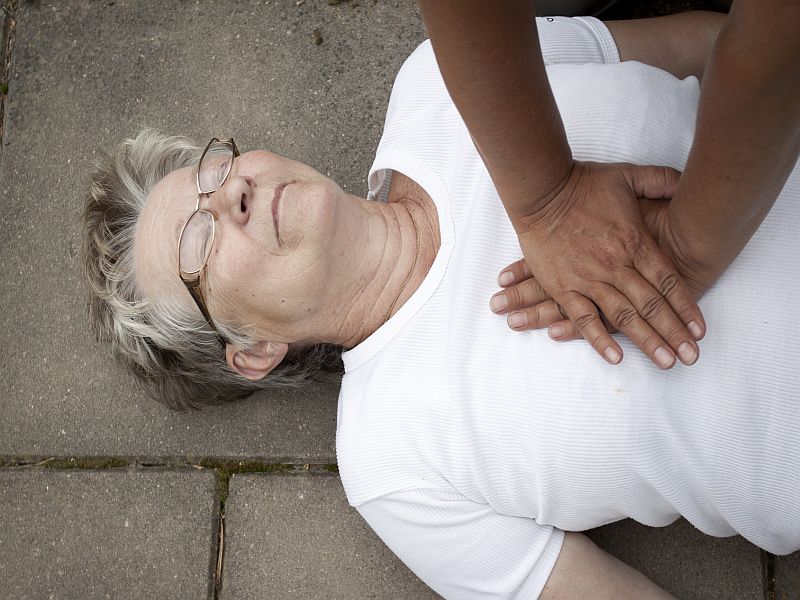
When someone goes into cardiac arrest, quick action from bystanders can have a long-lasting impact, researchers say.
Not only were the patients more likely to survive, they were also significantly less likely to sustain brain damage or enter a nursing home in the following year, a new study found.
It’s well known that cardiac arrest victims have a better shot at surviving if witnesses jump into action, said lead researcher Dr. Kristian Kragholm.
That means performing chest compressions or, if possible, using an automated external defibrillator (AED) — a layperson-friendly device that can “shock” a stopped heart back into rhythm.
The new study findings, Kragholm noted, show those actions have long-term benefits, too.
“Our study findings underscore the importance of learning how to recognize cardiac arrest, how to do chest compressions, and how to employ an AED,” said Kragholm, of Aalborg University Hospital, in Denmark.
Others agreed. “These data are very important,” said Dr. Zachary Goldberger, an assistant professor at the University of Washington School of Medicine, in Seattle.
“I think the bottom line is clear,” Goldberger said. “We all should be ready to recognize and respond to cardiac arrest. We can all play a role in helping to save someone’s life — and, this shows, improve their long-term outcomes, too.”
Dr. Michael Kurz is an associate professor at the University of Alabama-Birmingham, and a spokesperson for the American Heart Association (AHA).
He said it’s important to have research like this that confirms the long-range impact of bystanders’ response to cardiac arrest.
“We don’t just want people to survive,” Kurz said. “We want them to be able to go home to their families and get back to their lives.”
In the United States, more than 350,000 people suffer cardiac arrest outside of a hospital each year, according to the AHA.
In 2016, the group says, only 12 percent of those who suffered cardiac arrest survived — though that actually marks progress over previous rates.
Survival is dismal because, without emergency treatment, cardiac arrest is fatal within minutes.
Cardiac arrest occurs when the heart suddenly stops beating and cannot pump blood and oxygen to the body. If a bystander performs cardiopulmonary resuscitation (CPR), that keeps the victim’s blood circulating — buying time until paramedics arrive. It is not a heart attack, which is caused by a blockage that stops blood flow to the heart.
Better yet, bystanders can also use an AED, if one is available.
The devices automatically analyze the heart’s rhythm, Kurz explained, then deliver a shock to restart the heart if appropriate.
Experts have known those bystander actions improve victims’ 30-day survival odds, Kragholm said. But their impact in the long run has been less clear.
So, the new study followed over 2,800 Danish adults who’d suffered an out-of-hospital cardiac arrest between 2001 and 2012, and survived to the 30-day mark.
Most had received chest compressions from a bystander — and the likelihood of that happening improved over time. Among people who’d suffered cardiac arrest in 2001, two-thirds had received CPR; by 2012, almost 81 percent had, the findings showed.
Meanwhile, the number treated with an AED rose from 2 percent to nearly 17 percent.
And those good Samaritans made a lasting difference, the study found.
Overall, roughly 19 percent of survivors had brain damage or were admitted to a nursing home. But that was cut to 12 percent if bystanders performed CPR, and 8 percent if they used an AED, Kragholm said.
There was a similar effect on survival. Overall, 15 percent died within a year. That rate was 8 percent among people who’d received CPR, Kragholm said, and only 2 percent among those who’d been treated with an AED.
The findings were published May 4 in the New England Journal of Medicine.
According to Kragholm, Denmark started several campaigns during the study period that probably explain the rising rates of CPR and AED use.
CPR training became mandatory in elementary school and for people applying for a driver’s license, he said.
Plus, a national AED registry was formed. That registry, Kragholm said, was linked to emergency dispatch centers nationwide, so that staff could tell callers where to find the nearest AED.
Goldberger said he thinks teaching CPR in school is a good idea.
For now, he and Kurz both recommended that people learn about basic CPR — by taking a class in their community, for example.
Anyone can use an AED, Goldberger noted, even without training.
Of course, an AED may not always be nearby. But the devices are often available in places where large crowds gather, such as transportation hubs and sports stadiums. Some restaurants and other businesses also have them, Goldberger said.
More information
The American Heart Association has more on cardiac arrest.
Source: HealthDay

Leave a Reply